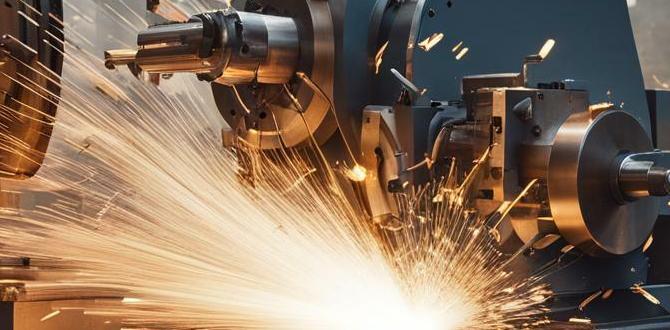A carbide end mill makes machining tough 304 stainless steel achievable and long-lasting. Using the right type, speeds, and feeds ensures a “genius” tool life, preventing frustration and delivering precise results for your projects. We’ll show you how to master it.
Machining 304 stainless steel can feel like wrestling a stubborn, sticky bear. It’s a fantastic material for its strength and corrosion resistance, but it loves to grab, chatter, and wear down standard cutting tools in a hurry. This often leaves beginners discouraged, thinking their machines aren’t up to the task or that stainless steel is just too difficult to work with. But what if I told you there’s a secret weapon that makes this challenging material feel almost friendly? It’s called a carbide end mill, and when you use it correctly, it can give you an astonishingly long and productive “life” when cutting 304 stainless. Let’s unlock this capability together and turn your stainless steel projects from a headache into a triumph!
Why Carbide End Mills Are Your Best Friend for 304 Stainless Steel
When we talk about tackling 304 stainless steel, we’re dealing with a material that’s a bit of a tough nut to crack. It’s known for being gummy, work-hardening quickly, and generating a lot of heat. These characteristics can be brutal on cutting tools, especially those made from high-speed steel (HSS). HSS tools can overheat, lose their temper, and dull rapidly, leading to poor surface finishes and frustration. This is precisely where carbide end mills shine like a beacon.
Carbide, also known as tungsten carbide, is an incredibly hard and rigid material. It boasts superior heat resistance compared to HSS, which is critical when cutting sticky materials like stainless where heat management is key. This hardness allows carbide end mills to cut through tough metals cleanly, resist wear, and maintain their sharp edge for much longer. For beginners, this means fewer tool changes, more predictable results, and a significantly smoother machining experience. Think of it as bringing a tougher knife to a knife fight – you’re just better equipped for the job.
Understanding the “Genius” Features of Carbide End Mills
Not all carbide end mills are created equal, especially when it comes to tackling 304 stainless steel. The “genius” in this context comes from specific design features that are optimized for these challenging materials. Let’s break down what to look for:
- Material Composition: While typically tungsten carbide, the specific grain size and binder content are crucial. Finer grain carbides are generally harder and more brittle, while coarser grains offer more toughness. For stainless steel, a good balance is often found in micro-grain or sub-micron grain carbides.
- Coatings: The right coating acts like a microscopic force field, reducing friction, increasing lubricity, and providing an extra layer of heat resistance. For 304 stainless, common and effective coatings include:
- TiN (Titanium Nitride): A universal coating, great for general machining and provides good hardness.
- TiCN (Titanium Carbonitride): Offers higher hardness and better abrasion resistance than TiN, making it excellent for stainless steel.
- AlTiN (Aluminum Titanium Nitride): A top performer for stainless steels and high-temperature alloys. It forms a protective aluminum oxide layer at higher temperatures, allowing for even higher cutting speeds and better heat management. This is often the go-to for “sticky” materials.
- ZrN (Zirconium Nitride): A good alternative to TiN, offering better lubricity and a higher melting point.
- Flute Geometry: The shape and number of cutting edges (flutes) play a vital role.
- Number of Flutes: For stainless steel, more flutes (like 4 or even 5 flutes) are generally preferred over 2-flute end mills when slotting or pocketing. More flutes provide better chip evacuation, which is critical for gummy materials, and allow for faster feed rates in finishing passes. However, 2-flute end mills are often used for general-purpose milling and can work well if chip evacuation is managed. For heavy roughing, specialized high-performance flute counts might be used.
- Helix Angle: A higher helix angle (e.g., 30° to 45°) helps “lift out” chips better and reduces the cutting forces, which is beneficial for gummy materials. Standard helix angles are usually around 30°.
- Core/Body Strength: A strong, robust core is essential to prevent chatter and tool breakage, especially in demanding applications.
- End Type:
- Square End: The most common type, used for general milling, facing, profiling, and creating square shoulders.
- Ball Nose: Useful for creating radiused corners, 3D contouring, and sculpting.
- Corner Radius: A square end with a small radius on the corners. This significantly strengthens the corners, reducing chipping and improving tool life when milling sharp inside corners or taking deep cuts. This is a highly recommended feature for stainless steel.
- Size and Reach: For 304 stainless, consider stub length or even “high performance” or “performance reduced neck” variants. A 1/8 inch 1/4 shank stub length carbide end mill is often a good choice for smaller projects or when rigidity on a benchtop mill is paramount. Stub length end mills have a shorter flute length relative to their diameter, which increases rigidity and reduces the tendency for chatter.
Selecting the Right Carbide End Mill: Your Cheat Sheet
Choosing the absolute best end mill for 304 stainless steel depends on your specific operation (roughing, finishing, slotting, profiling) and machine rigidity. However, for a beginner looking for versatility and good performance, here’s a solid starting point:
Recommended Carbide End Mill Features for 304 Stainless Steel
| Feature | Why it’s Great for 304 Stainless | Beginner Recommendation |
|---|---|---|
| Material | Carbide (Tungsten Carbide) offers superior hardness and heat resistance over HSS. | Standard micro-grain carbide. |
| Coating | AlTiN or TiCN coatings reduce friction, heat, and wear, improving tool life and finish. | AlTiN is often the best choice for stainless. TiCN is a close second. |
| Number of Flutes | 4 or 5 flutes improve chip evacuation and finish in gummy materials. | Start with a 4-flute end mill. A 2-flute can work for lighter cuts or lighter materials but is less ideal for sticky stainless. |
| Helix Angle | 30° to 45° helical flutes help lift chips and reduce cutting pressure. | A 30° helix angle is standard and effective. Higher is usually better for stainless. |
| End Type | A corner radius adds strength to the tip and reduces chipping. | Square end with a corner radius (e.g., 0.010″ or 0.020″ radius for a 1/4″ end mill). |
| Length/Reach | Shorter flute lengths (stub length) increase rigidity, reducing chatter. | Stub length or standard length. Avoid extended reach unless absolutely necessary. For smaller mills, a 1/4 shank stub length is ideal. A 1/8 inch end mill (often on a 1/4 inch shank) is great for detail work and portability. |
Choosing an end mill with a corner radius is a must for beginners when working with stainless steel. It dramatically increases the tool’s durability. A common and very useful size you’ll encounter is a 1/4 inch shank carbide end mill, often available in stub length. For finer details or smaller machines, a 1/8 inch carbide end mill (typically on a 1/4 inch shank) can also be a lifesaver.
Speeds and Feeds: The Secret Sauce for Stainless Steel
This is where most beginners stumble with stainless steel. It requires slower surface speeds (SFM) and relatively faster feed rates compared to softer metals like aluminum. The goal is to keep the tool engaged, push the chip, and avoid rubbing, which generates heat and work-hardens the material.
Surface Speed (SFM): For 304 stainless steel with a coated carbide end mill, a good starting point for the surface speed is between 100-250 SFM (Surface Feet per Minute). The exact number depends heavily on the coating, the rigidity of your setup, and the type of cut.
Chipload: This is the thickness of the chip being removed by each cutting edge. For stainless steel, you want a robust chipload to efficiently clear material and prevent the sticky material from welding to the tool. A typical chipload for a 1/4 inch end mill in 304 stainless might be between 0.001″ and 0.005″ per tooth.
To calculate the spindle speed (RPM) you need:
RPM = (SFM 3.82) / Diameter (in inches)
And to calculate the feed rate (IPM – Inches Per Minute):
Feed Rate (IPM) = RPM Number of Flutes Chipload (in inches)
Example Calculation for a 1/4″ Carbide End Mill in 304 Stainless Steel:
Let’s use some common values:
- Carbide End Mill Diameter: 0.250 inches
- Number of Flutes: 4
- Target Surface Speed (SFM): 150 SFM (a good middle ground for AlTiN coated carbide)
- Target Chipload per Tooth: 0.003 inches
Step 1: Calculate RPM
RPM = (150 SFM 3.82) / 0.250 inches
RPM = 573 / 0.250
RPM = 2292
So, aim for around 2300 RPM.
Step 2: Calculate Feed Rate (IPM)
Feed Rate = 2292 RPM 4 flutes 0.003 inches/tooth
Feed Rate = 27.5 inches per minute
So, aim for a feed rate of approximately 27-30 IPM.
Speed and Feed Considerations Table
| Factor | Impact on 304 Stainless | Recommendation |
|---|---|---|
| Surface Speed (SFM) | Too high = rapid tool wear, overheating. Too low = rubbing, poor finish, work hardening. | 100-250 SFM for coated carbide. Start moderate (e.g., 150 SFM) and adjust. |
| Chipload per Tooth (IPT) | Too high = tool breakage, chatter, poor surface finish. Too low = rubbing, heat buildup, work hardening. | 0.001″-0.005″ for 1/4″ end mill. Needs enough to create a distinct chip. |
| Spindle Speed (RPM) | Directly controls surface speed based on tool diameter. | Calculated from SFM and diameter. Always use the slowest RPM that allows for the correct SFM. For many hobby mills, this means running at their maximum RPM. |
| Feed Rate (IPM) | Too high = tool/part breakage, chatter. Too low = rubbing, work hardening, heat. | Calculated from RPM, flutes, and chipload. Must be fast enough to exceed low SFM and create a chip. |
| Depth of Cut (DOC) | Too deep = excessive force, breakage. Too shallow = rubbing, heat, work hardening. Engage tool gradually. | For roughing, 0.1-0.2 times the tool diameter. For finishing, much shallower. Use radial depth of cut (stepover) as well. |
| Radial Depth of Cut (Stepover) | Affects chip load and heat. Higher stepover for roughing, lower for finishing. | Roughing: 20-50% of diameter. Finishing: 5-15% of diameter. |
Always use a machining calculator or consult tool manufacturer recommendations if you’re unsure. Many CAM software packages will also suggest appropriate parameters.
Machining Strategies for Success with 304 Stainless
Beyond just the tool and speeds/feeds, how you machine makes a huge difference. Here are some strategies to employ:
- Rigidity is King: Ensure your workpiece is clamped securely. Use a vise with hardened jaws if possible. Minimize any overhang of the end mill in the collet or tool holder – this is where a stub length comes into play. A solid machine setup reduces vibration and chatter.
- Use Cutting Fluid/Lubricant: This is non-negotiable for 304 stainless. It cools the cutting zone, lubricates the interface between the tool and workpiece, and flushes away chips. Flood coolant is ideal, mist coolant is a good alternative, and even a good quality cutting paste or oil applied regularly with a brush can help significantly.
- Chip Evacuation: Stainless steel chips can be long and stringy. Ensure your flutes are clear. If you’re machining a deep pocket, consider using a helical interpolation (ramping) or lifting out chips periodically. For blind holes, peck drilling with the end mill can be helpful.
- Ramping In: Instead of plunging straight into the material, use a ramping motion. This gradually engages the tool into the material, reducing shock and heat. Most CAM software can help you program this. For manual milling, a slight pre-drilled hole and a gentle helical movement can work.
- Climb Milling vs. Conventional Milling:
- Climb Milling: The tool teeth move in the same direction as the feed. This generally results in a better surface finish, less chatter, and longer tool life, especially in harder materials like stainless. It pushes the chip away from the tool. This requires a backlash-free or rigid feed system (common on modern CNCs).
- Conventional Milling: The tool teeth move against the feed direction. This tends to create more radial force and can be harder on the tool. It’s often used when backlash is a concern.
If your machine has a rigid feed system, always try climb milling for stainless steel.
- Finishing Passes: For best results, do roughing in one or two passes, then take a light finishing pass with a lower chipload and feed rate (but maintain the SFM). This will give you a superior surface finish.
Tips for Extending Carbide End Mill “Life”
The “genius 304 stainless steel life” isn’t just about the tool’s inherent quality; it’s about how you treat it. Here’s how to get the absolute most out of your carbide end mills:
- Keep them sharp: Even carbide can become dull. If you notice increased chatter, poor surface finish, or higher cutting forces, it’s time to consider re-sharpening or replacing the tool.
- Avoid Dwelling: Don’t let the cutting edge sit in one spot. Constant engagement and chip formation are key.
- Machine Cool: Heat is the enemy of cutting tools. Use plenty of coolant and ensure good chip evacuation.
- Don’t Push Too Hard: While you need sufficient chipload, trying to hog out too much material too quickly will only lead to tool breakage or premature wear.
- Store Properly: Keep your end mills clean and protected in a holder or case to prevent nicks and damage.
- Consider Toolholders: A good quality collet or tool holder with a tight grip is essential. ER collets are popular for good runout







